The right dog food is THE foundation of the dog’s health.
Not only the physical. Also, the psychological. And even the educative one.
The better the dog is supplied with nutrients, the more efficient his nervous system is able to handle stress factors and compensate for excessive reactions.
A lack of certain nutrients – can and will – increase nervous sensitivity and make the dog’s life more difficult.
Also, proper food lowers the frustration level. By being fun and enjoyable. Especially, when the world is perceived with the nose, and you therefore have a sense of taste, a thousand times better than humans, thanks to your galactic olfactory bulb.
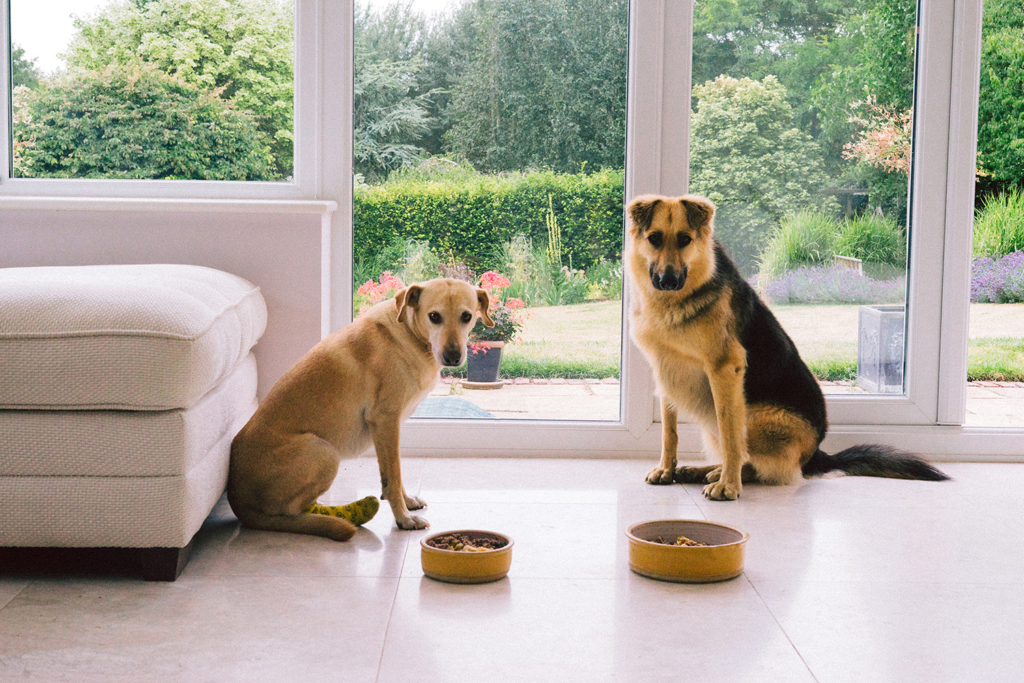

The Myth of the bad eater
The dog knows the difference between your steakhouse burger and his dry food misery. And not infrequently, experiences an active sense of injustice. Experiences frustration.
Already witnessed dozens of times in the course of our many house sits, with our own dogs.
The dogs we sit for, usually get cheap dry food or a dubious wet food-dry food combo, which few of them eat well.
If they realize, that I serve real food to my dogs, they often refuse their own food entirely.
Bad eaters turn into food refusers. Protesting, crying, yowling, even offended food refusers.
And this only because they noticed, that other dogs are served real food. This is pure self consciousness! Injustice consciousness.
No, they are not bad eaters, as often titled by their owners. They are simply tired of the instant food! And I feel damn sorry for them, because I live closely with them during my many house sits and am forced to feed in two worlds.
I generally feed my own dogs out of sight of the “bad eaters”. Anything else would be torture, and I am not authorized, as a dog sitter, to change their food.
A disgrace, I call it, to be denying the dog one of the most important things in his existence: Real food.
If you don’t believe me, go enjoy a bag of Chappi. For yourself, of course, not for the dog.
Doesn’t taste good? Is disgusting? A thousand strange things in it? The dog thinks so too!
But you can change it. You can end the misery together.
Which side of the buffet do you choose?
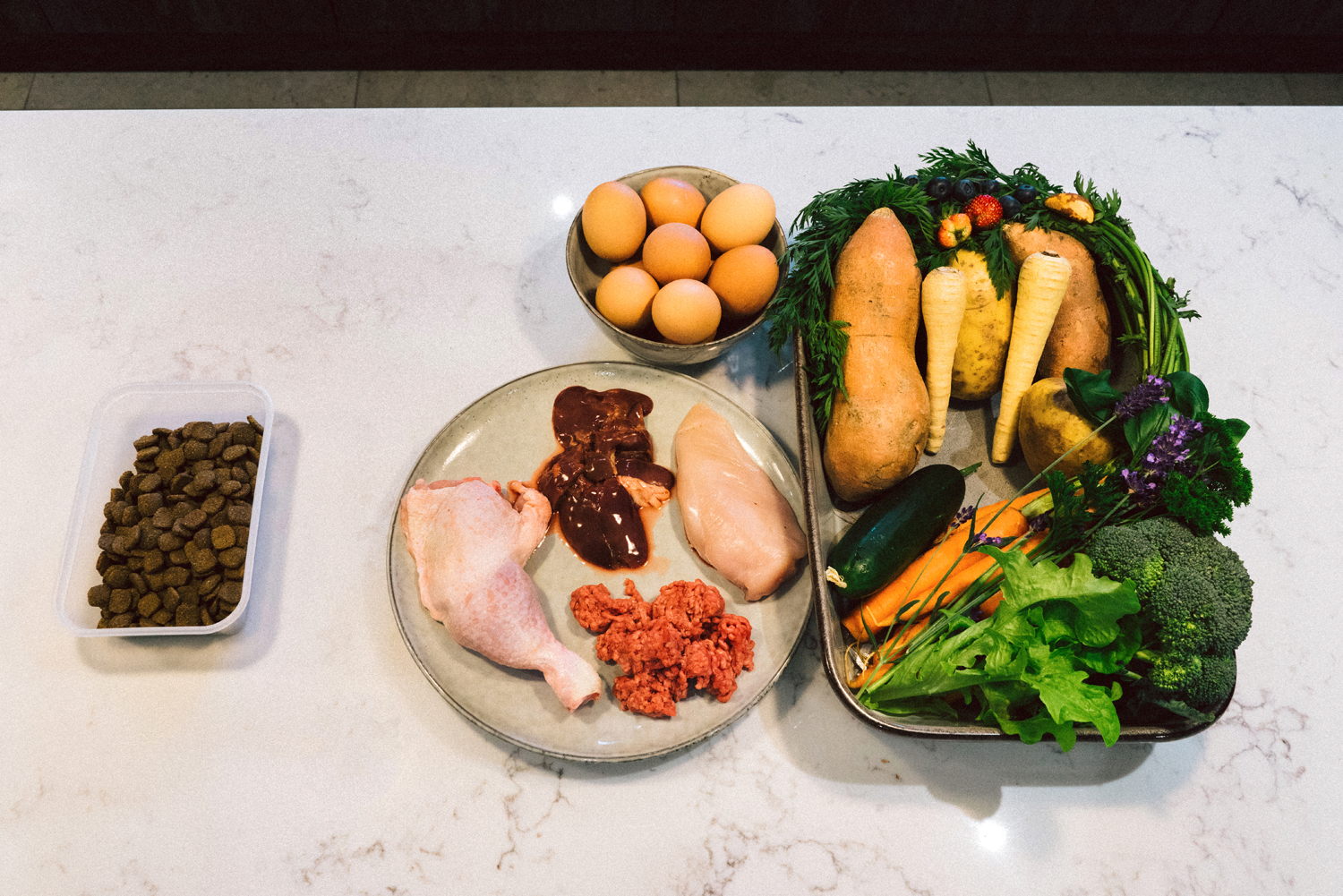
Science for the common dog lover

- The wolf is a carnivore, a meat eater.
- The dog is, scientifically speaking, a mixture of carnivore, the meat eater, and omnivore, the anything eater.
- The dog has lived together with man for 30,000 years.
- The dog’s body has adapted to the food of man.
- The dog is able to, depending on the breed, digest starch.
- The dog has developed, depending on the breed, the ability to grind movements of the jaw, through the formation of a slightly in-turned jaw joint.
- The molars, depending on the breed, are similar to bunodont molars, slightly rounded to allow some grinding of plant food.
- The canine intestine is longer than the wolf’s, depending on the breed. Almost as long as the human intestine.
- The dog cannot break down cellulose. Therefore, plant foods should be mashed.
- The dog cannot produce vitamin D through the skin, but needs vitamin D from food.
- The dog can form bile acid, which is important for fat digestion, only if the amino acid taurine is present in sufficient quantities.
- The dog needs sufficient arginine to maintain its nitrogen balance.
Half of the points are typically omnivorous. Half of the points are typically carnivorous. Depending on the breed, the dog tends more in one or the other direction.
Why breed-dependent?
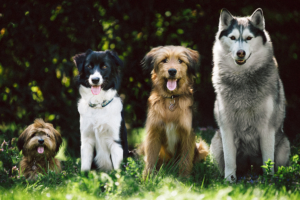
Because the transformation of the dog’s body depended on the food supply of the domesticating human culture. And not every culture ate the same everywhere.
The Husky example
Nordic breeds were domesticated by people of the far north. Siberia, Alaska, Canada, etc. There, people mainly ate meat and fish, for thousands of years. The body of Nordic breeds is adapted to a highly carnivorous diet, similar to that of the wolf. Starch digestion is much less developed, than that of typical companion dogs of the West.
The Herd Guard Dog example
In their countries of origin, Herd Guard Dogs were and are mostly fed grain oatmeal and bread. Meat is less common. Accordingly, their digestion is specialized on carbohydrates. Herd Guard Dog experts speak of a maximum meat content of 50%.
Western omnivores
Dog breeds of western latitudes are usually adapted to an omnivorous diet. To what grandfather hunted in the forest and grandmother picked up in the field.
Despite all statistics, it is necessary to try out what the individual dog tolerates. The mixture of the individual breeds is too great. Too branched the family tree. Too small the universal knowledge of mankind.
A standard only exists with regard to one thing: Real food is better than what was left of it, after the seventh factory.
How I feed (while traveling and beyond)
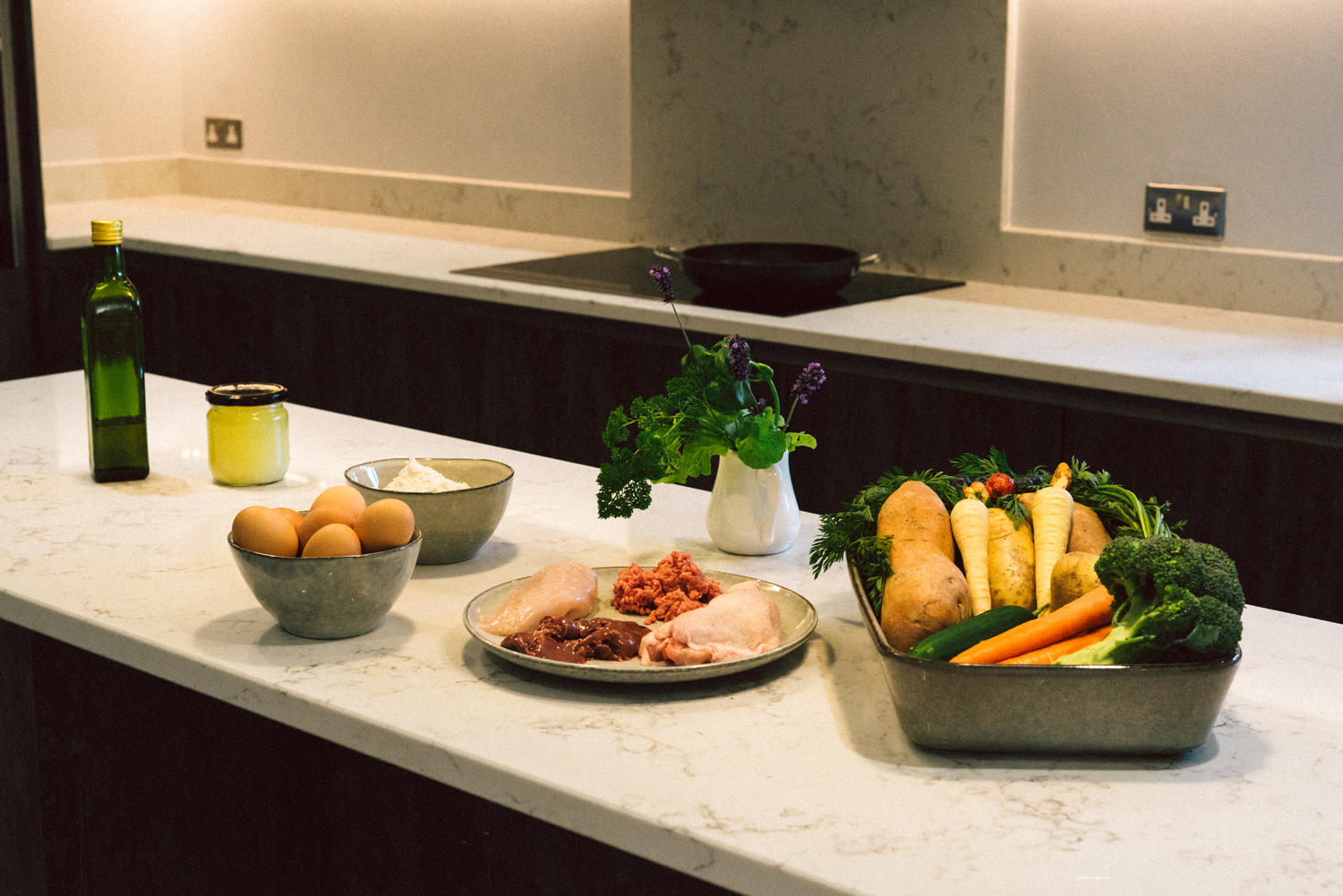

I have been following the concept of Paleo low-carb for years.
For myself and for my dogs. That means: Fresh, unprocessed, real food, organic and pasture-raised, whenever possible.
90% of the time, I cook for my dogs.
They get fresh meat in the morning and freshly cooked vegetables in the evening. I explain my exact cooking plan further down in the text.
Depending on the country, travel schedule, cooking possibilities and on relocation days, cooking is not possible. Then I fall back on a good wet food can.
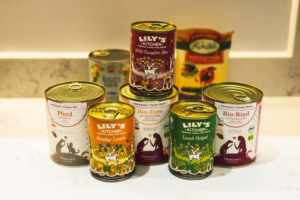
In my eyes “good” means, that the can contains only real meat and real vegetables, with a meat content between 50% and 80%. It must be openly declared and contain absolutely no nonsense like sugar, preservatives, flavor enhancers or such fun as “plant and animal by-products”.
Good are, for example, the Herrmanns, Defu and Terra Canis brands. In the UK, we use Lily’s Kitchen wet food.
I wouldn’t feed canned food in the long term. Canned food is a temporary solution, when we don’t have cooking facilities available.
We reject dry food of any kind, as a general rule. Just like closed declared products and food from companies like Pedigree, Chappi and their evil brothers.
For the record: I buy all the recommended products out of conviction and am not paid by any company.
Cooking for the dog – The Knowledge Basics
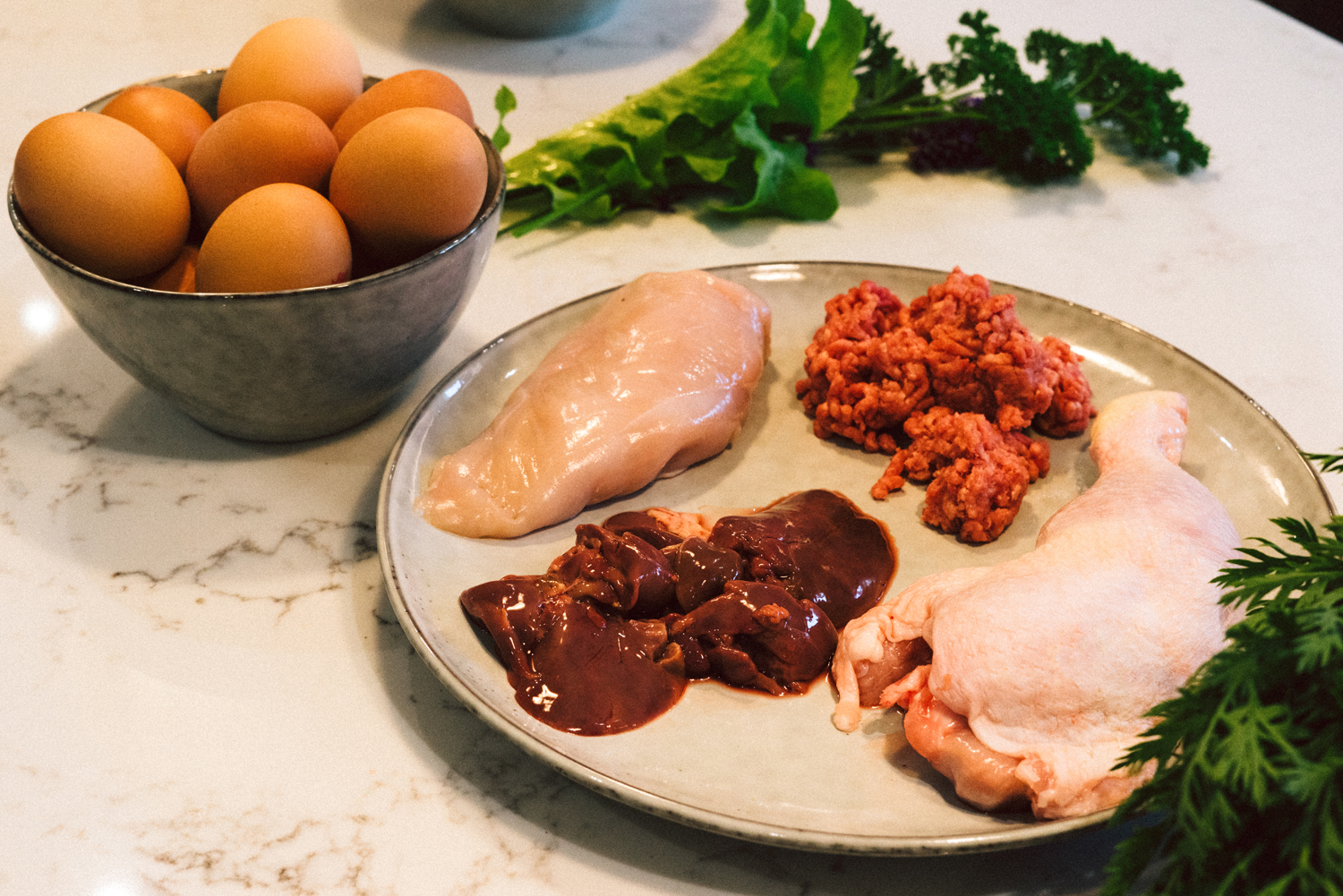
Protein
The protein requirement of the dog is 2-6 g/kg (1-3 gram per pound of body weight), depending on the breed.
Animal protein has a much better bioavailability than vegetable protein. It even has a higher nutrient density, if from a good source.
Too much protein can over acidify the kidneys and is excreted unused. The amount of meat must be adjusted to the needs of the individual dog. The highest possible meat content is not a predicate for good food.
I feed a meat ratio of 50%.
This meets the protein requirements of my dogs with 4 g/kg (2 gram per pound). It also leaves some room for a few chewing snacks.
Once a week, I replace meat with the same amount of egg. I heat the egg white, because raw egg white isn’t healthy for dogs. Egg yolks can be fed raw.
My dogs are used to both, raw and cooked meat. However, raw and cooked meat should never be fed at the same time.
Note: Please do not feed pork or wild boar. It may contain the Aujeszky virus, which is harmless to humans and deadly to dogs and cats.
Muscle Meat
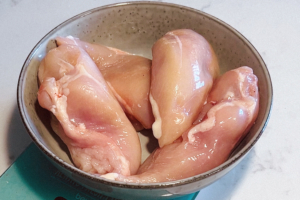
Muscle meat should be, with about 50%, the main component of meat feeding and ideally be well infused with fat.
I speak of striated muscle, or skeletal muscle meat, and leave out exotic varieties, such as tongue and co. Since we get our meat from the regular supermarket while traveling, the choice is limited.
I make sure that at least 50% of the muscle meat consists of red meat, to meet the iron requirements of the dogs.
Organs
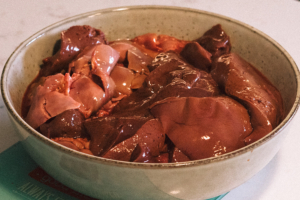
Organs have an extremely high nutrient density, compared to muscle meat.
We feed one meal of pure organs per week. Feeding liver is a must, due to the unmatched abundance of vitamins and minerals.
The dog has a liver need of 1-2 g/kg (0,5 – 1 gram per pound of body weight) or 5% of the total feed.
Our weekly organ meal basically consists of 50% liver.
The other half consists of spleen, kidney or heart.
Eggs
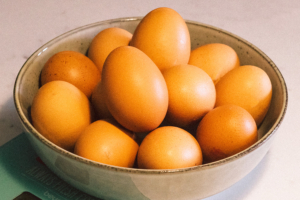
Eggs are bursting with nutrients, making them a welcome variety in my dogs’ meaty diet. Once a week, I replace a complete meat meal with the same amount of eggs. The yolk can be fed raw. The egg white must be heated, because it contains the biotin binder avidin, which can cause biotin deficiency in the dog. Heating deactivates avidin. Problem solved. However, we heat our eggs completely, because Tia prefers scrambled eggs. Pure cooked egg whites are too gooey for her.
Bones
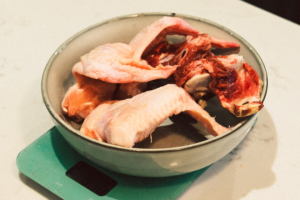
The calcium demand of the dog is 50 mg/kg.
Since a bone-free dog diet doesn’t cover the calcium requirement, calcium-containing foods must be fed in addition.
Raw meaty bones are best as calcium sources. “Raw and meaty” means an approximate bone-to-meat ratio of 1:1.
Bare raw bone should be preceded by a raw meat meal. Meat cushions the intestines and ensures adequate production of gastric acid.
Bones must be fed raw only. Heated bones become porous and splinter. This also applies to minced bones.
If whole or ground bones cannot be fed, for whatever reason, then bone meal or meat bone meal are the first choice. It is important to make sure that the calcium to phosphorus ratio is around 2:1. This ratio is most likely to be found in meat bone meal.
If the ratio is at the same level (as with poor quality bone meal) or if there is a lot of calcium but no phosphorus (as with eggshell powder) or if significantly more phosphorus is fed than calcium (as with a pure meat diet without calcium supplementation), there will be an unfavorable shift in the mineral balance, which can make the dog sick in the long term.
We use one of the following calcium sources once a week:
Rib (raw and meaty): 5000 mg CA /100 g
Breastbone (raw and meaty): 3000 mg CA /100 g
Poultry bones (raw and meaty): 2000 mg CA /100 g
Carcass (raw and meaty) 1000 mg CA /100g
Meat bone meal with Ca-Ph 2:1
Dangers of Bone Feeding
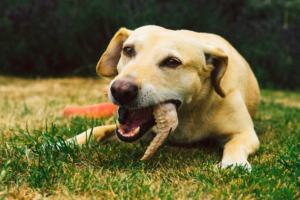
Some dogs get constipation from bones, called bone feces. Bone feces can be very painful for dogs and in extreme cases, can lead to intestinal obstruction, requiring treatment.
The organism needs time to adjust to bone digestion. Feeding bones should be started with very small amounts and increased very slowly.
If the feces become harder, the amount should be reduced. If constipation occurs, bone feeding should be suspended immediately.
To facilitate bone digestion, the following steps can be tried:
- Favor soft bones of poultry and small animals under turkey size. Avoid hard bones of poultry above turkey size, lamb, veal, beef, horse, game.
- Prefer minced bones.
- Spread the bone feeding out over the week, to avoid larger amounts at one time.
- Do not feed bare bones, but meaty bones, so that it flows more easily. Fed together with mashed vegetable and oil, it flows even better.
- Only feed entire bones to dogs with good dentition and sufficient chewing activity. Otherwise there is an increased risk of injury.
It is also important to be present during bone feeding. Bones can get stuck in the tooth or throat, which requires immediate assistance.
Do not feed: Carrying bones of large animals and marrow bones
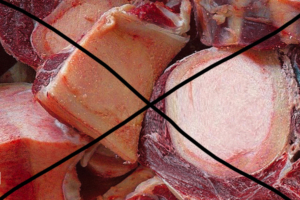
Weight-bearing bones are leg bones. These should not be fed, because they are extremely hard and able to break teeth. Exceptions are the weight-bearing bones of small animals under turkey size, such as chicken and rabbit. These can be fed.
Marrow bones, which are popular in dog diets, also belong to the category of weight-bearing bones. Marrow bones are round, hollow discs of the leg bone, filled with bone marrow. On one hand, they are harmful to teeth, due to their hardness. On the other hand, the dog can wrap the round, hollow bone around his lower jaw and seriously injure himself. Marrow bones are a no-go in dog feeding.
Exception: Feed only the marrow, by prior scraping or boiling.
Do not feed: Throat and Larynx
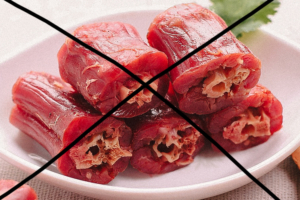
I personally do not feed anything from the throat area, due to the possibility of thyroid being eaten along with it. I have thyroid problems myself and know what too much “stuff” can do. A neck or two is not going to hurt any dog. However, I would not recommend feeding it, on a regular basis.
Do not feed: Heated Bones
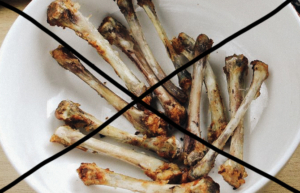
Feeding heated bones is absolutely taboo. No matter, if boiled, baked or grilled. They splinter and can seriously injure the dog internally.
Chewing Snacks

Dogs have a natural need to chew. This need must be met. Dogs want to chew and should chew. Chewing is fun. Chewing keeps them busy. Chewing calms. Chewing strengthens the teeth and cleans them.
My dogs are allowed to chew 4 times a week. That’s all the pants can take and my wallet allows.
On Sundays, they chew their raw meaty bone for breakfast. Mon/Wed/Fri they chew on a chew snack, which I give them 2-3 hours after dinner.
I make sure, that the chew is of natural origin and gives them chewing fun for at least 20 minutes. Sometimes even 60 mins, if the quality is right.
I mostly use beef scalp, bull’s pizzle and beef ears with fur.
Those who have puppies, mini dogs or dogs with bad teeth can use rabbit ears, chicken feet, rumen and other soft stuff. Big dogs, however, will breathe these snacks away in 10 seconds. For us, wasted calories, without any added value for the big, active chewer.
I don’t recommend:
- Pig’s ears (although very rare, may contain Aujeszky’s virus, which is deadly for dogs).
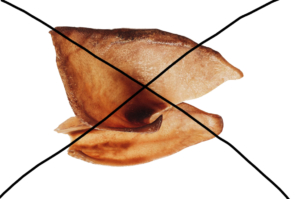
- Hooves, antlers, wood, chewy root (splinter hazard and extremely sharp).
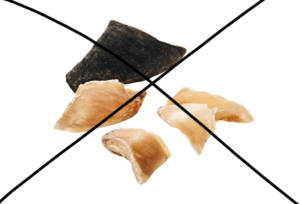
- Dried ham bones (caused us painful constipation, which required treatment)
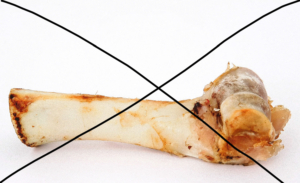
- Any artificial chews or processed beef skin, in typical bone form (usually made in China and heavily contaminated with toxins).
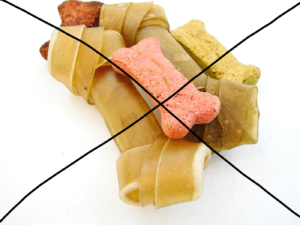
It is important, as with general feeding, to be present. If a piece of chewing bone gets stuck in the tooth or throat, the owner must be able to help immediately.
Carbohydrates
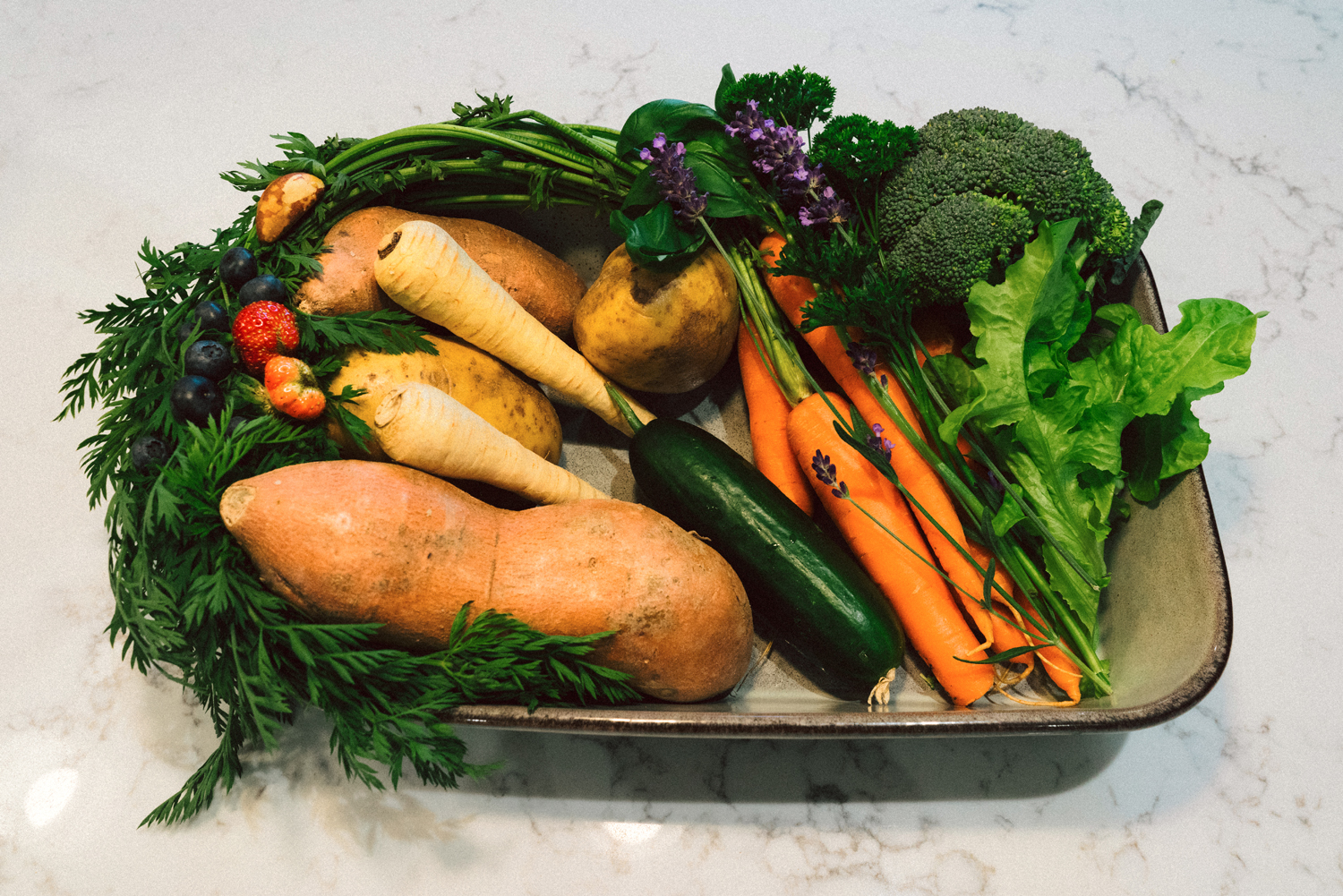
Most dog breeds can, may, and should digest carbs.
Their digestion has adapted to the omnivorous human.
However, not all carbohydrates, that humans have ever consumed, are species-appropriate. Neither for humans, nor for dogs.
Bread, pizza and pasta are empty, dead, disease-causing carbohydrates.
Today’s grain is bred for high performance and nutrient poverty.
We don’t feed grain in any form. It simply provides no benefits. Only downsides.
Healthy, living carbohydrate foods are, first and foremost, vegetables. Starchy vegetables for energy building.
Low-starch vegetables, as a source of fiber and minerals.
My dogs don’t get fruits. Sometimes a brown banana, if it’s left over, or berries from the bushes. Otherwise, fruits contain too much sugar and are not needed, in my opinion.
Our veggie portion is 50% high starch and 50% low starch. This keeps us in the low-carb range, keeps insulin levels stable, and has a high fiber content in the food. For better tolerance, I mix only two vegetables per meal. One starchy and one low starch.
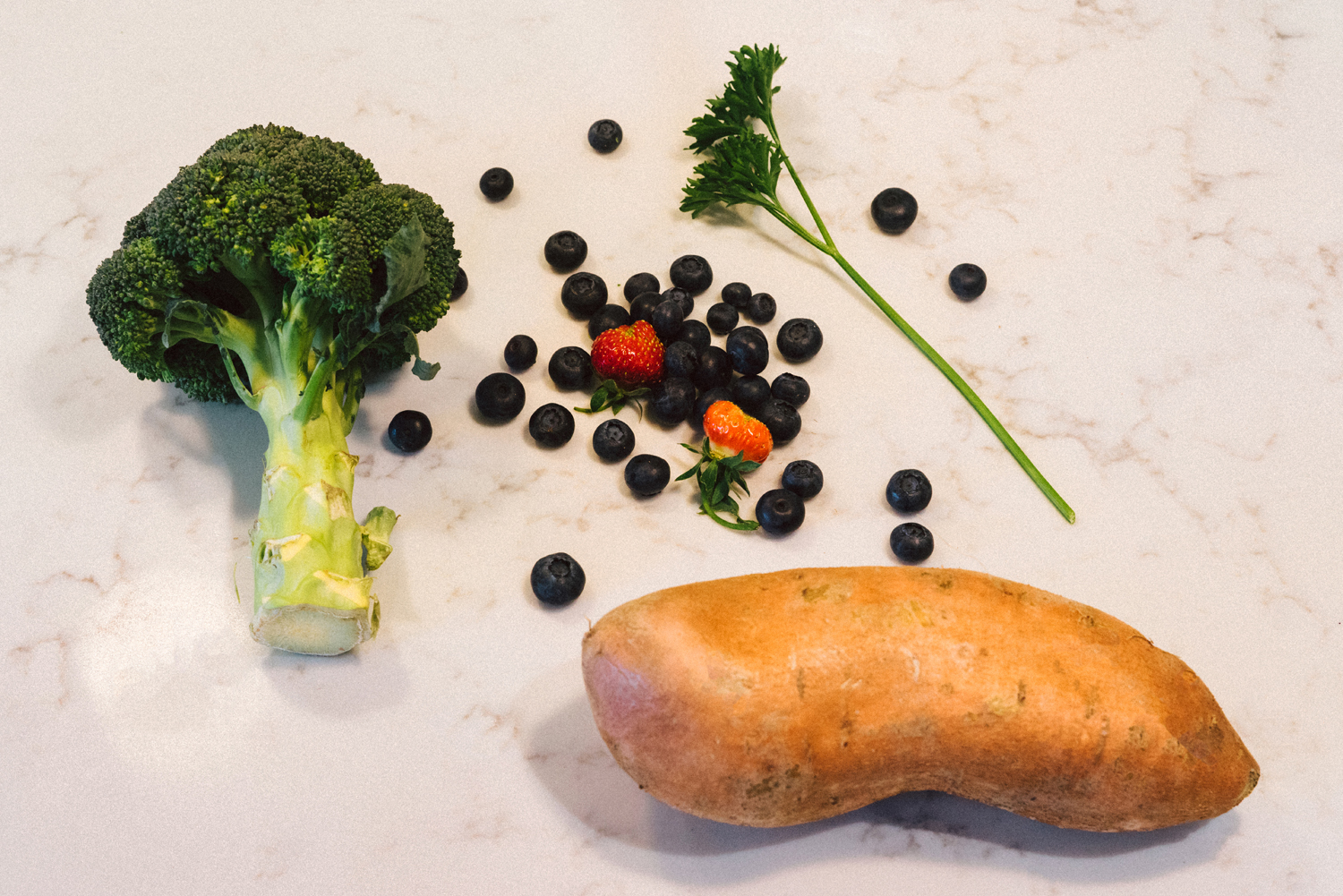
On carbohydrate-rich vegetables we use:
- Sweet Potato 20 g KH / 100 g
- Potato 15 g KH / 100 g
- Parsnip 12 g KH / 100 g
- Hokkaido 12 g KH / 100 g
- Butternut 12 g KH / 100 g
On low-carbohydrate vegetables we use:
- Carrots 8 g KH / 100 g
- Beet Root 8 g KH / 100 g
- Root Parsley 5 g KH / 100 g
- Asparagus 4 g KH / 100 g
- Kohlrabi 4 g KH / 100 g
- Zucchini 3 g KH / 100 g
- Broccoli 3 g KH / 100 g
- Green Beans 3 g KH / 100 g
- Green Cabbage 3 g KH / 100 g
- Celery 3 g KH / 100 g
- Cauliflower 2 g KH /100 g
- Cucumber 2 g KH / 100 g
- Fennel 2 g KH / 100 g
- Salat 2 g KH / 100 g
In addition, herbs in small quantities, depending on availability. Parsley, basil, lavender, rosemary, chamomile, etc.
Please keep in mind: Dogs can digest vegetables best, when they are mashed.

I throw it in the pot in the morning, boil it for half an hour, mash it, add fat and leave it on the stove until evening.
Then they get it room-temperatured.
As a rule, I chop the food only after cooking, so that as few nutrients as possible are lost to the water.
If I were sedentary, I would cook a month’s supply and freeze it in a monstrous freezer.
Fat
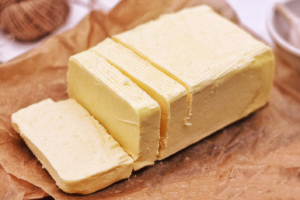
I regulate the weight of my dogs with the added amount of fat.
Not by taking away or adding meat and vegetables, because this serves their basic supply with nutrients and not the figure planning.
I add fat according to my feeling and sense of proportion. I add about 15 – 25 g fat per dog to their dinner veggies, in maintenance requirements.
In the deep winter, a little more, because they have a higher consumption due to the cold. On hot summer days, a little less, because they move less in the heat.
So if they were out at the North Sea for 6 hours at 2 degrees, more fat is fed. If they spent the whole day at 25 degrees under the apple tree, less fat is fed.
On fat we use, depending on availability:
- Fresh animal fat
- Beef tallow
- Goose fat
- Butter
- Ghee
- Oliveoil
Nutritional supplements
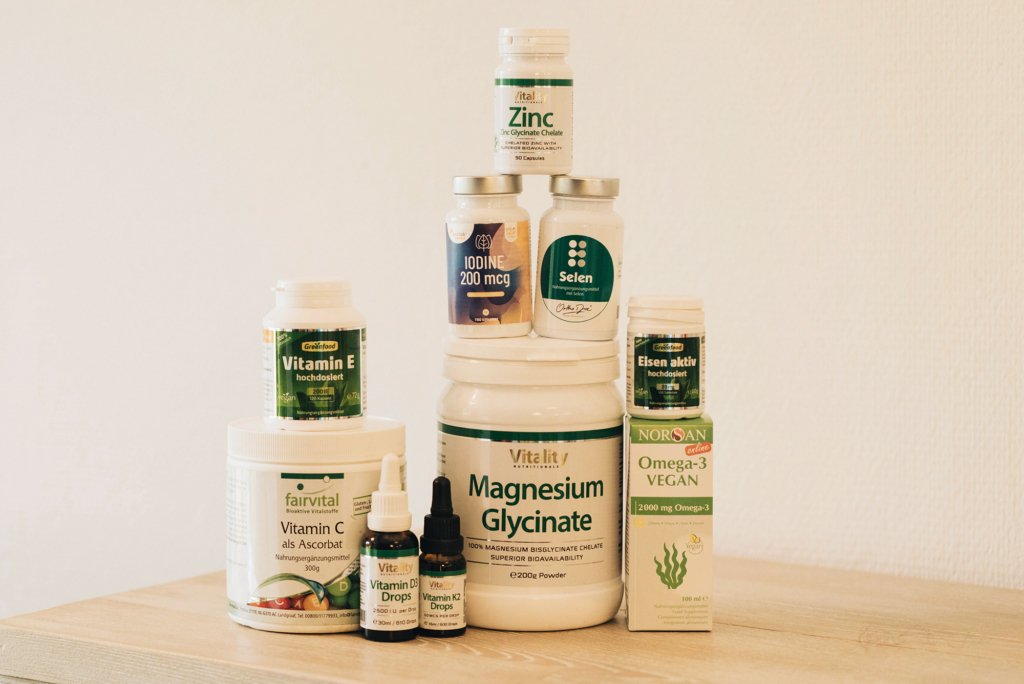
I am, confessedly, a fan of nutritional supplements, in the sense of science-based orthomolecular medicine.
I am not a fan of homeopathy, so please don’t confuse the two.
Ideally, all vital nutrients are covered by food. This is not always possible. It is very easy to find out, whether supplements are necessary.
The rule: check, measure and replenish.
- Check what is contained in the daily food
- Measure what arrives in the blood.
- Replenish what is missing.
Our personal food analysis has shown, that almost all vitamins are covered by food, but not all minerals and trace elements.
We supplement Vitamin D + K2, Magnesium, Omega 3, Iodine, Vitamin E, Zinc and Iron.
We also add Vitamin C, if needed. Dogs can synthesize Vitamin C by themselves, but only, if all co-factors are provided and the intestine is functioning perfectly. This Vitamin C synthesis is limited in case of illness, at stressful times or at old age. Therefore, we supplement with 0.5 – 1g per dog, per day, if necessary. In case of illness, we also supplement 50 µg of selenium, as the demand increases and our food just covers the daily needs.
We don’t use an all in one preparation, but buy the nutrients individually, so that we can dose them perfectly and have a free hand over the nutrient compounds.
If you cook for your dog yourself, it is obligatory to read up on the subject.
There are certain substances, which can not be covered by normal food and must be supplemented, for example Vitamin D.
But even with ready-made food, a look at the added substances is worthwhile. These are not infrequently underdosed, sometimes missing completely or are in a poorly digestible form.
For the record: I am not a veterinarian and am only describing what I give my dogs. The right supplement for my dogs may be inappropriate for other dogs. Please do not simply copy, but in case of any doubts, consult a specialist or, in consultation with the nutritionist veterinarian, rather use a ready-made preparation, until sufficient knowledge for independent dosing is achieved.
Overview
Total amount of food
4 % / weight / day
Composition
50 % meat, 50 % plant based
Breakfast
4x/week muscle meat (2x red, 2x white)
1x/week organs (50 % liver + 50 % spleen, kidney or heart) 1x/week raw meaty bones
1x/week egg
Dinner
50 % high-carbohydrate vegetables,
50 % low-carbohydrate vegetables, fat
Chews
3x/week beef skin, bull’s pizzle or beef ears with fur.
Morning supplements
Vitamin D + K2
Magensium
Omega 3
Iodine
Vitamin E
Vitamin C, if needed
Selenium, if needed
Evening supplements
Magnesium
Zinc
Iron
Salt, if needed
Vitamin C, if needed
Food Table
| Mo | Di | Mi | Do | Fr | Sa | So | |
|---|---|---|---|---|---|---|---|
| Breakfast | Muscle Meat | Muscle Meat | Egg | Organs | Muscle Meat | Muscle Meat | Raw Meaty Bones |
| Dinner | Veggies Fat | Veggies Fat | Veggies Fat | Veggies Fat | Veggies Fat | Veggies Fat | Veggies Fat |
| Chew | X | X | X |
Supplement Table
| Morning | Evening |
|---|---|
| Vitamin D 2500 IE (Tia daily, Sandy Mon-Fri) Vitamin K2 50 mcg (Tia daily, Sandy Mon-Fri) Magnesium 100 mg (daily) Iodine 200 mcg (daily) Omega 3 5ml (Mon, Wed, Fri) Vitamin E 70 mg (Mon, Wed, Fri) 500 mg Vitamin C (if sick) 50 µg Selenium (if sick) | Zinc 12 mg (daily) Magnesium 100 mg (daily) Iron 20 mg before bed(Mon, Wed, Fri) 500 mg Vitamin C (if sick) Salt (weather/activity dependent) |



